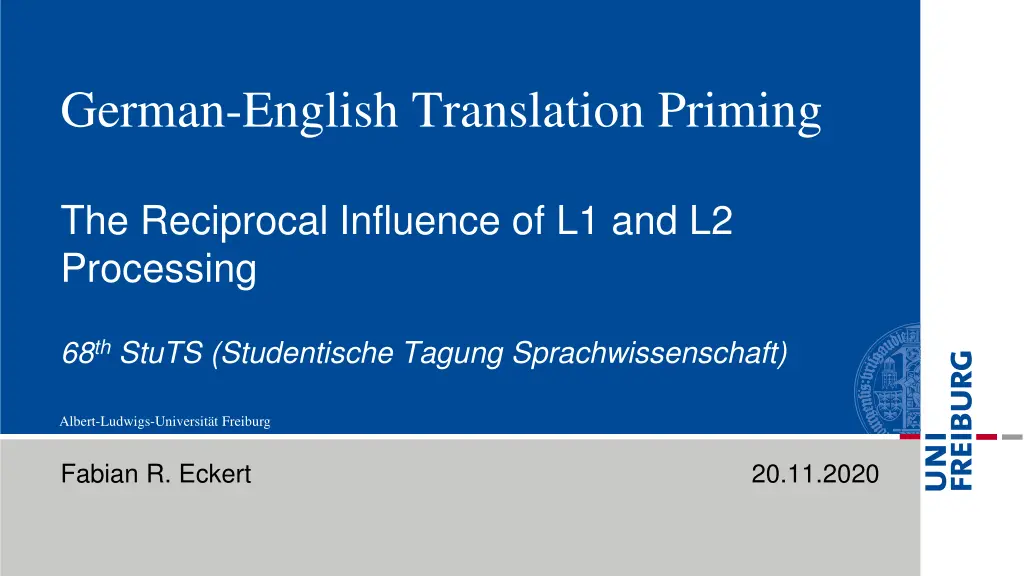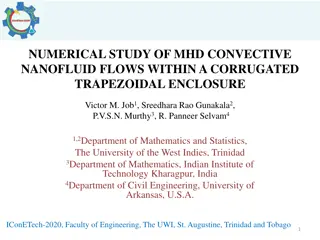
Bilingual Lexical Processing Research: Cross-Language Priming Experiments
Explore the reciprocal influence of L1 and L2 processing in German-English bilinguals through cross-language priming experiments. Investigate lexical representations and the impact of L1 on L2 processing. Replication studies and methodological considerations also discussed.
Download Presentation

Please find below an Image/Link to download the presentation.
The content on the website is provided AS IS for your information and personal use only. It may not be sold, licensed, or shared on other websites without obtaining consent from the author. If you encounter any issues during the download, it is possible that the publisher has removed the file from their server.
You are allowed to download the files provided on this website for personal or commercial use, subject to the condition that they are used lawfully. All files are the property of their respective owners.
The content on the website is provided AS IS for your information and personal use only. It may not be sold, licensed, or shared on other websites without obtaining consent from the author.
E N D
Presentation Transcript
German-English Translation Priming The Reciprocal Influence of L1 and L2 Processing 68thStuTS (Studentische Tagung Sprachwissenschaft) Albert-Ludwigs-Universit t Freiburg Fabian R. Eckert 20.11.2020
Bilingualism Definition by Grosjean (1992): - Bilingualism is the regular use of two (or more) languages and bilinguals are those people who need and use two (or more) languages in their everyday lives. Investigation of German-English bilinguals (German as native language)
Lexical Representations in Bilinguals Tisch Desk
Lexical Representations in Bilinguals Tisch Tisch Desk Desk
Cross-Language Priming Experiments designed to research the influence of L1 on L2 processing & vice versa Studies conducted in several languages: - Spanish-English (Davis et al. 2019) - Dutch-English (van Hell & Dijkstra 2002) - Japanese-English (Nakayama, Ida & Lupker 2015) - German-English translation priming not extensively researched
German-English Translation Priming Replication study with different language combination Methodology close to Schoonbaert, Duyck, Brybaert & Hartsuiker (2009), reliant on Jiang & Forster (2001) and Jiang (1999)
German-English Translation Priming Measuring reaction time - Online survey/experiment - Dependent variable: reaction time in ms Lexical decision paradigm - Is this a real word of English/German? - Buttons on keyboard on laptop/PC (Non-)Translation primes - Priming before targets with either random word or translation
Methodological Considerations Translation priming paradigm (Altrarriba & Basnight- Brown 2007) - Cognates - Word length & frequency - Relatedness proportion - Stimulus onset asynchrony - Nonword ratio
Participants 27 German native speakers - Mean age = 22.22 - 22 university students - Most frequent other languages: French & Spanish - Intermediate to advanced English level Language of instruction & survey = German
Stimuli 100 stimuli in total - 60 target word / 40 nonword 5 different conditions / 20 each: - Congruent prime - Incongruent prime - No prime - Nonword - Nonword + prime For each language & condition combination: 10 stimuli
Stimuli - Examples Congruent prime - war KRIEG, love LIEBE, weltall SPACE, blut BLOOD Incongruent prime - fire ESSEN, ladder BRIEF, efeu EARTH, wurst VALUE No prime - STADT, ABEND, HUMAN, SOUND Nonword - AMBEN, LOTUE, GRAIO, DIRVY Nonword + prime - berry HOHIN, car LEGAM, haus WORSK, luft SNILE
Stimuli Non-cognates Nouns 5 letters Frequency: 100-1000 per million words Translations: share no more than 2 letters, 3-7 letters Orthographically and phonetically different Designed using the WordGen program by Duyck, Desmet, Verbeke & Brysbaert (2004) on the basis of the CELEX database of Baayen, Piepenbrock & Van Rijn (1993)
Procedure P a u s e P a u s e P a u s e Experimental Block I English-German Experimental Block II German-English Training Block I English-German Training Block II German-English
Procedure prime trials ########## 500ms prime 50ms 50ms ########## 150ms TARGET Designed using PsyToolkit by Stoet (2010 & 2017) 1000ms
Procedure non-prime trials ########## 500ms ########## 50ms 50ms ########## 150ms TARGET Designed using PsyToolkit by Stoet (2010 & 2017) 1000ms
Hypotheses Congruence / Incongruence Bilingual Asymmetry Proficiency
Hypotheses 1. Congruence/Incongruence Hypothesis - Priming a correct translation will lead to shorter reaction times than an incorrect translation - Regardless of direction - congruent RT < incongruent RT
Bilingual Asymmetry L1 L2 L2 L1 As argued by Schoonbaert, Hartsuiker & Pickering (2007), Duyck (2005), Keatley, Spinks & de Gelder (1994)
Hypotheses 2. Bilingual Asymmetry Hypothesis - Priming English targets with German translation primes will elicit a stronger effect than the opposite - Stronger priming effect of L1 on L2 than other way round
Hypotheses 3. Proficiency Hypothesis - More proficient bilinguals will exhibit stronger priming effects than less proficient ones - Proficiency impacts priming strength - E.g. Lee, Jang & Choi (2018)
Hypotheses Congruence / Incongruence Bilingual Asymmetry Proficiency
Results Reactions Times Block Mean RT German: 597.17ms Mean RT English: 672.92ms Condition Mean RT congruent: 591.75ms Mean RT incongruent: 633.32ms Significant difference (F = 5.45, p = .021) Significant difference (F = 9.96, p = .002)
Results German Targets Mean RT congruent: 583.91ms Mean RT incongruent: 610.42ms English Targets Mean RT congruent: 599.9ms Mean RT incongruent: 656.24ms No significant difference (t = -1.31, p = .195) Significant difference (t = -2.81, p = .007)
Results Proficiency Index No significant difference (F = 3.42, p = .068)
Hypotheses Congruence / Incongruence Bilingual Asymmetry Proficiency
Hypotheses Congruence / Incongruence Bilingual Asymmetry Proficiency
Hypotheses Congruence / Incongruence Bilingual Asymmetry Proficiency
Results German Targets Mean RT congruent: 583.91ms Mean RT incongruent: 610.42ms English Targets Mean RT congruent: 599.9ms Mean RT incongruent: 656.24ms No significant difference (t = -1.31, p = .195) Significant difference (t = -2.81, p = .007)
Hypotheses Congruence / Incongruence Bilingual Asymmetry Proficiency
Results Reactions Times Block Mean RT German: 597.17ms Mean RT English: 672.92ms Condition Mean RT congruent: 591.75ms Mean RT incongruent: 633.32ms Significant difference (F = 5.45, p = .021) Significant difference (F = 9.96, p = .002)
Hypotheses Congruence / Incongruence Bilingual Asymmetry Proficiency
Lexical Representations in Bilinguals Tisch Tisch Desk Desk
Thank you for your attention! Albert-Ludwigs-Universit t Freiburg Fabian R. Eckert 20.11.2020
Sources Altarriba, Jeanette & Dana M. Basnight-Brown. 2007. Methodological considerations in performing semantic- and translation-priming experiments across languages. Behavior Research Methods 39(1). 1 18. https://doi.org/10.3758/BF03192839. Baayen, H. R., R. Piepenbrock & H. van Rijn. 1993. The CELEX lexical database. Philadelphia: University of Pennsylvania: Linguistic Data Consortium. Davis, Chris, Rosa S nchez-Casas, Jos E. Garc a-Albea, Marc Guasch, Margarita Molero & Pilar Ferr . 2010. Masked translation priming: Varying language experience and word type with Spanish English bilinguals. Bilingualism: Language and Cognition 13(2). 137 155. https://doi.org/10.1017/S1366728909990393. Duyck, Wouter. 2005. Translation and Associative Priming With Cross-Lingual Pseudohomophones: Evidence for Nonselective Phonological Activation in Bilinguals. Journal of Experimental Psychology: Learning, Memory, and Cognition. US: American Psychological Association 31(6). 1340 1359. https://doi.org/10.1037/0278-7393.31.6.1340. Duyck, Wouter, Timothy Desmet, Lieven P. C. Verbeke & Marc Brysbaert. 2004. WordGen: A tool for word selection and nonword generation in Dutch, English, German, and French. Behavior Research Methods, Instruments, & Computers 36(3). 488 499. https://doi.org/10.3758/BF03195595.
Sources Grosjean, Fran Lois. 1992. Another View of Bilingualism. In Richard Jackson Harris (ed.), Advances in Psychology (Cognitive Processing in Bilinguals), vol. 83, 51 62. North-Holland. https://doi.org/10.1016/S0166-4115(08)61487-9. http://www.sciencedirect.com/science/article/pii/S0166411508614879 (25 August, 2020). Hell, Janet G. van & Ton Dijkstra. 2002. Foreign language knowledge can influence native language performance in exclusively native contexts. Psychonomic Bulletin & Review 9(4). 780 789. https://doi.org/10.3758/BF03196335. Jiang, Nan. 1999. Testing processing explanations for the asymmetry in masked cross-language priming. Bilingualism: Language and Cognition. Cambridge University Press 2(1). 59 75. https://doi.org/10.1017/S1366728999000152. Jiang, Nan & Kenneth I. Forster. 2001. Cross-Language Priming Asymmetries in Lexical Decision and Episodic Recognition. Journal of Memory and Language 44(1). 32 51. https://doi.org/10.1006/jmla.2000.2737. Keatley, Catharine W., John A. Spinks & Beatrice De Gelder. 1994. Asymmetrical cross-language priming effects. Memory & Cognition 22(1). 70 84. https://doi.org/10.3758/BF03202763. Lee, Yoonhyoung, Euna Jang & Wonil Choi. 2018. L2-L1 Translation Priming Effects in a Lexical Decision Task: Evidence From Low Proficient Korean-English Bilinguals. Frontiers in Psychology. Frontiers 9. https://doi.org/10.3389/fpsyg.2018.00267. https://www.frontiersin.org/articles/10.3389/fpsyg.2018.00267/full (13 June, 2020).
Sources Nakayama, Mariko, Keisuke Ida & Stephen J. Lupker. 2016. Cross-script L2-L1 noncognate translation priming in lexical decision depends on L2 proficiency: Evidence from Japanese English bilinguals*. Bilingualism: Language and Cognition. Cambridge University Press 19(5). 1001 1022. https://doi.org/10.1017/S1366728915000462. Schoonbaert, Sofie, Wouter Duyck, Marc Brysbaert & Robert J. Hartsuiker. 2009. Semantic and translation priming from a first language to a second and back: Making sense of the findings. Memory & Cognition 37(5). 569 586. https://doi.org/10.3758/MC.37.5.569. Schoonbaert, Sofie, Robert J. Hartsuiker & Martin J. Pickering. 2007. The representation of lexical and syntactic information in bilinguals: Evidence from syntactic priming. Journal of Memory and Language 56(2). 153 171. https://doi.org/10.1016/j.jml.2006.10.002. Stoet, Gijsbert. 2010. PsyToolkit: A software package for programming psychological experiments using Linux. Behavior Research Methods 42(4). 1096 1104. https://doi.org/10.3758/BRM.42.4.1096. Stoet, Gijsbert. 2017. PsyToolkit: A Novel Web-Based Method for Running Online Questionnaires and Reaction-Time Experiments. Teaching of Psychology. SAGE Publications Inc 44(1). 24 31. https://doi.org/10.1177/0098628316677643.
German-English Translation Priming The Reciprocal Influence of L1 and L2 Processing 68thStuTS (Studentische Tagung Sprachwissenschaft) Albert-Ludwigs-Universit t Freiburg Fabian R. Eckert 20.11.2020






















